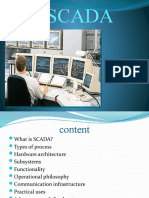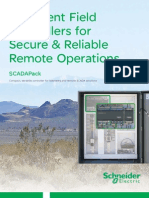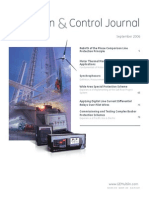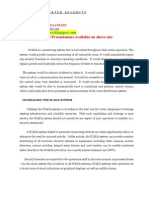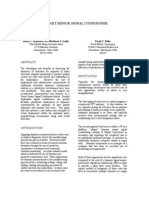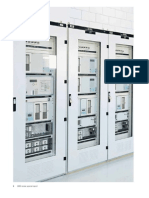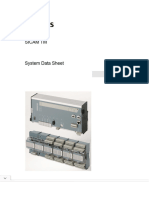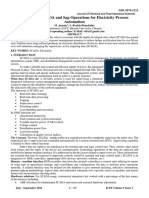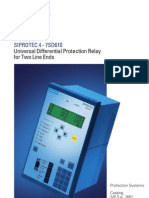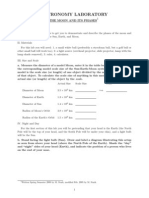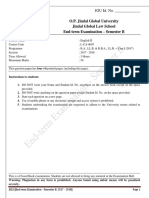Consider The Advantages of Digital Hydraulic Valves: Applications
Consider The Advantages of Digital Hydraulic Valves: Applications
Uploaded by
Jaikishan KumaraswamyCopyright:
Available Formats
Consider The Advantages of Digital Hydraulic Valves: Applications
Consider The Advantages of Digital Hydraulic Valves: Applications
Uploaded by
Jaikishan KumaraswamyOriginal Description:
Original Title
Copyright
Available Formats
Share this document
Did you find this document useful?
Is this content inappropriate?
Copyright:
Available Formats
Consider The Advantages of Digital Hydraulic Valves: Applications
Consider The Advantages of Digital Hydraulic Valves: Applications
Uploaded by
Jaikishan KumaraswamyCopyright:
Available Formats
Ideas &
Applications
By Richard T. Schneider
Consider the advantages of digital hydraulic valves
nalog hydraulic valves both from reduced installation and servo and proportional wiring costs to greater functionalhave served industry well for sev- ity, increased flexibility, and simeral decades. Of course, for very plified valve setup. precise applications, system designToday, sectors of the hydraulics ers had to learn to make allowances industry are driving towards openfor their limitations. Among them: architecture components. Open ar susceptibility to electromagnetic chitecture calls for such developinterference and transmission ments as standardized cables and losses over long lengths of cable. connectors, clearly defined dataCare had to be taken to ensure in- exchange mechanisms, and pubtegrity of low-power analog signals. lished device profiles. Open archi only modest diagnostic and mon- tecture interfaces protect machine itoring capabilities. Typically, ana- builders investments in the devellog valves provide only an all or opment of digital device communinothing digital fault signal. With cation software. this limited information, tracking At the protocol layer, Moogs inidown a root-cause problem can be tial Digital Interface Valve (DIV) a time-and-money-consuming task. Moogs Digital Interface Valve is inflexibility. Functional- based on integral 32-bit, floatingity is set at the factory. point microprocessor that closes Analog valves need cen- all control loops. Extensive device tralized control-system ar- monitoring and fault detection are chitecture with a power- built in. Valve supports CANbus ful central controller, interface, one analog input, which must interface with and one analog each independent device output. on the machine. Today, electronic technology and miniaturization can bypass these limitations of analog valves. At conforms Moogs Industrial Controls to CANopen. This Div., we believe that the standard clearly defines the time for digital valves has arrived. Our experience with this new data-exchange mechanism so that product platform suggests that the the inter-operability between confuture will focus on configurable, forming devices is guaranteed. At outer-loop motion and pressure the application layer, the DIV comclosed-loop controls directly at plies with the Proportional Valve Device Profile (first proposed by the valve. Digital valves integral micro- the VDMA organization of Gerprocessors can close control loops many). This standard specifies the and provide extensive device-mon- functionality of all devices of the itoring, fault-detection, and com- same family. Detailed knowledge munication capabilities. They offer of the fieldbus is unnecessary with the many benefits of open and de- a human/machine interface in centralized system architecture place, so system designers can fo-
cus on the application. The DIV fits well into both centralized and decentralized systems. One benefit of decentralized architecture is that serial wiring to each component replaces parallel wiring. Serial wiring reduces installation and connection costs. It also enhances flexibility because systems can be changed or extended easily. Tasks of subsystems are assigned to local devices, reducing the complexity and required processing power of the main controller. The DIVs embedded digital microprocessor is the foundation for enhanced functionality and flexibility (as compared with its analog counterparts). Configurable valve functions enable users to define the valves dynamic behavior and adapt its characteristics to particular application requirements. Field-programmable functions include four-quadrant demand ramp conditioning, dead band compensation, demand limits, direction dependent gains, and access to valve tuning parameters. Detailed diagnostic status information, available over the digital bus, improves safety and reliability and simplifies maintenance. This information includes programmable control deviation monitoring, vendor name, model numbers and the like. Elimination of external analog demand conditioning boards and simplified P/Q valve setup save cost. Daniel Halloran, head of the Controls and Electronics Section at Moogs Industrial Controls Div., provided this discussion. Contact Moog at 800 / 272-6664 or visit www.moog.com/industrial.
8 Hydraulics & Pneumatics s September 2002
You might also like
- 100 Most Essential Literary Works Workbook: Do We Really Have To Read Everything On The ELA Reading List?Document101 pages100 Most Essential Literary Works Workbook: Do We Really Have To Read Everything On The ELA Reading List?NiamatNo ratings yet
- Karen) - WarrenDocument272 pagesKaren) - WarrenEmese Alter100% (2)
- Cutler-Hammer: Learning Module 26: DevicenetDocument41 pagesCutler-Hammer: Learning Module 26: Devicenetksenthil77No ratings yet
- Scad ADocument31 pagesScad AnareshkattaNo ratings yet
- İngilisDocument5 pagesİngilisnurlan.babanliNo ratings yet
- SCADAPack Product BrochureDocument16 pagesSCADAPack Product BrochureAqua Technology Group100% (1)
- Design and Simulation of Remote Monitoring of The Intelligent Automatic Control System in The Production LineDocument10 pagesDesign and Simulation of Remote Monitoring of The Intelligent Automatic Control System in The Production LineIAES IJAINo ratings yet
- Dwatch: Grid SolutionsDocument4 pagesDwatch: Grid SolutionsFlogisto79No ratings yet
- PCJ 2006-09Document100 pagesPCJ 2006-09lisusedNo ratings yet
- Digital Control Handbook 1971Document423 pagesDigital Control Handbook 1971Kevin G. Rhoads100% (1)
- Control de Bombas PLC - MainDocument8 pagesControl de Bombas PLC - MainGabo DuarNo ratings yet
- Smart DevicesDocument16 pagesSmart DevicesmanojchandrasekharanNo ratings yet
- Benefits of Distribution AutomationDocument27 pagesBenefits of Distribution AutomationPavani YadavNo ratings yet
- Optimization Techniques Reducing Periodic Maintenance and Retrofit Outage Times With Digital Substation Technology Thomas Werner, Stefan Meier Switzerland ABBDocument13 pagesOptimization Techniques Reducing Periodic Maintenance and Retrofit Outage Times With Digital Substation Technology Thomas Werner, Stefan Meier Switzerland ABBVolniNo ratings yet
- Easyconnect Smartwire Connecting Instead of WiringDocument12 pagesEasyconnect Smartwire Connecting Instead of WiringfabimedinaysubandajmNo ratings yet
- DeviceNet Technical Overview PDFDocument2 pagesDeviceNet Technical Overview PDFThanh BaronNo ratings yet
- Design of Scada Using Microscada For Substation Automation SystemDocument8 pagesDesign of Scada Using Microscada For Substation Automation SystemAsif RazaNo ratings yet
- Scada in Water SecurityDocument5 pagesScada in Water SecurityBharadwaj SanthoshNo ratings yet
- Intelligent Motor ManagementDocument3 pagesIntelligent Motor ManagementjunfaNo ratings yet
- The Next Generation of Smart Substations. Challenges and PossibilitiesDocument9 pagesThe Next Generation of Smart Substations. Challenges and PossibilitiesK Vijay Bhaskar ReddyNo ratings yet
- Power Plant AutomationDocument3 pagesPower Plant AutomationAbdelRhman Elfky0% (1)
- Multifunction Digital Relays For Generator ProtectionDocument10 pagesMultifunction Digital Relays For Generator Protectionfreddy riveraNo ratings yet
- Synopsis - AVR Based Realtime Online Scada With Smart Electrical Grid Automation Using Ethernet 2016Document19 pagesSynopsis - AVR Based Realtime Online Scada With Smart Electrical Grid Automation Using Ethernet 2016AmAnDeepSinghNo ratings yet
- 1983 A Fault Tolerant Digital Control System For Turbo MachineryDocument7 pages1983 A Fault Tolerant Digital Control System For Turbo MachinerysheyunfengNo ratings yet
- Transmission Object Terminals: Station Automation & ProtectionDocument14 pagesTransmission Object Terminals: Station Automation & ProtectionSajeed ParackalNo ratings yet
- A Smart Sensor Signal Conditioner: Mark I. Schiefer and Michael J. Lally Paul C. EdieDocument7 pagesA Smart Sensor Signal Conditioner: Mark I. Schiefer and Michael J. Lally Paul C. EdieSandy VichuNo ratings yet
- Can OrgDocument150 pagesCan Orgmail87523No ratings yet
- The Concept of IEC 61850Document7 pagesThe Concept of IEC 61850reva_rkNo ratings yet
- AutomtaizacionDocument302 pagesAutomtaizacionhmc41277No ratings yet
- AutomtaizacionDocument302 pagesAutomtaizacionjoticamario123No ratings yet
- Digital Substation FINALDocument32 pagesDigital Substation FINALarjun hugarNo ratings yet
- General Development of Multiplexing: Section 6Document16 pagesGeneral Development of Multiplexing: Section 6Sco JoNo ratings yet
- ScadaDocument13 pagesScadamdayyub50% (6)
- Commissioning and Maintenance Testing of Multifunction Digital RelaysDocument10 pagesCommissioning and Maintenance Testing of Multifunction Digital RelaysASHOK KUMAR MUWALNo ratings yet
- The Azerbaijani Experiences in Digital Substation Deployment. How Process Bus and IEC 61850 Addresses Utility RequirementsDocument18 pagesThe Azerbaijani Experiences in Digital Substation Deployment. How Process Bus and IEC 61850 Addresses Utility Requirementspo ghNo ratings yet
- CP Survey Monitoring ProductsDocument7 pagesCP Survey Monitoring Productsrajauae2008No ratings yet
- Motorpact 72kV CatalogueDocument58 pagesMotorpact 72kV CatalogueRobert GalarzaNo ratings yet
- MC Set Vacuum Catalogue PDFDocument50 pagesMC Set Vacuum Catalogue PDFfasa9009No ratings yet
- Power Quality and Energy Metering Product Range OverviewDocument6 pagesPower Quality and Energy Metering Product Range OverviewISGENo ratings yet
- How Advanced On-Line Partial Discharge Diagnostics Can MakeDocument12 pagesHow Advanced On-Line Partial Discharge Diagnostics Can MakeBucur Ilie100% (1)
- PCMDocument181 pagesPCMsagsgNo ratings yet
- DCS_Vs_SCADA_1731749341Document42 pagesDCS_Vs_SCADA_1731749341form910No ratings yet
- Wireless Condition Monitoring: Battery-Powered, On-Line Data-AcquisitionDocument10 pagesWireless Condition Monitoring: Battery-Powered, On-Line Data-AcquisitionManel Montesinos100% (1)
- Water Consultants Checklist Final March 2019Document12 pagesWater Consultants Checklist Final March 2019Víctor CasadoNo ratings yet
- SICAM TM System Data Sheet - 018125328Document78 pagesSICAM TM System Data Sheet - 018125328jakelingonzalezNo ratings yet
- Integrating SCADA and Sap Operations For Electricity Process AutomationDocument3 pagesIntegrating SCADA and Sap Operations For Electricity Process AutomationHakim BenmajidNo ratings yet
- 6964 CSImplementing BW 20200130 WebDocument9 pages6964 CSImplementing BW 20200130 WebbudiartoeliyantoNo ratings yet
- Paper Iec61850 in PortugalDocument13 pagesPaper Iec61850 in PortugalBogdan DiaconuNo ratings yet
- The Key Role of Intelligent Electronic Devices (IED) in Advanced Distribution Automation (ADA)Document7 pagesThe Key Role of Intelligent Electronic Devices (IED) in Advanced Distribution Automation (ADA)WOndewosen AbelNo ratings yet
- DeltaV System Overview v11 BrochureDocument40 pagesDeltaV System Overview v11 Brochureelio_hbNo ratings yet
- Lecture Notes Unit 2 Smart Grid1Document25 pagesLecture Notes Unit 2 Smart Grid1Saurabh BhardwajNo ratings yet
- Circuit Breaker System Using Iot Based Smart Load ControlDocument29 pagesCircuit Breaker System Using Iot Based Smart Load Controlkalemula sahithiNo ratings yet
- Benefits of Digital Substation TechnologyDocument5 pagesBenefits of Digital Substation TechnologyMohd AlghunimatNo ratings yet
- 7sd610 CatalogueDocument35 pages7sd610 CatalogueTntngn Petualang100% (1)
- Presentation Process Bus ConceptDocument27 pagesPresentation Process Bus Conceptbrijendra21No ratings yet
- ISA Certified Automation Professional (CAP) Associate: Certification Exam Prep: 500 Practice Exam Questions and ExplanationsFrom EverandISA Certified Automation Professional (CAP) Associate: Certification Exam Prep: 500 Practice Exam Questions and ExplanationsNo ratings yet
- Maintenance AuditDocument16 pagesMaintenance AuditJaikishan Kumaraswamy100% (2)
- Listening TestDocument9 pagesListening TestJaikishan KumaraswamyNo ratings yet
- 6 Steps Beyond 5 WhysDocument29 pages6 Steps Beyond 5 WhysJaikishan Kumaraswamy100% (4)
- 2050 2e6Document6 pages2050 2e6Jaikishan KumaraswamyNo ratings yet
- 2030 3eDocument6 pages2030 3eJaikishan KumaraswamyNo ratings yet
- 2040 2e6Document6 pages2040 2e6Jaikishan KumaraswamyNo ratings yet
- 1050 1e6Document6 pages1050 1e6Jaikishan KumaraswamyNo ratings yet
- 2030 3eDocument6 pages2030 3eJaikishan KumaraswamyNo ratings yet
- The Strengths of An Effective Electrical Safety System: NEMA PublicationDocument5 pagesThe Strengths of An Effective Electrical Safety System: NEMA PublicationJaikishan KumaraswamyNo ratings yet
- Pneumatics Ensures Food-Processing ReliabilityDocument5 pagesPneumatics Ensures Food-Processing ReliabilityJaikishan KumaraswamyNo ratings yet
- BatteryDocument2 pagesBatteryJaikishan KumaraswamyNo ratings yet
- Best Maint PracticesDocument13 pagesBest Maint PracticesJaikishan KumaraswamyNo ratings yet
- Belt Drive Preventive Maintenance and Safety ManualDocument67 pagesBelt Drive Preventive Maintenance and Safety ManualJaikishan KumaraswamyNo ratings yet
- Maintenance AuditDocument16 pagesMaintenance AuditJaikishan Kumaraswamy100% (2)
- Maintenance in MotionDocument8 pagesMaintenance in MotionJaikishan KumaraswamyNo ratings yet
- Thrust BRG FailureDocument1 pageThrust BRG FailureJaikishan KumaraswamyNo ratings yet
- ICe Plant Sizing QuestionnaireDocument1 pageICe Plant Sizing QuestionnaireJaikishan KumaraswamyNo ratings yet
- Programme OutlineDocument3 pagesProgramme OutlineKhanNo ratings yet
- Zenith Revision Schedule Target 2021Document1 pageZenith Revision Schedule Target 2021SahilNo ratings yet
- ABO Anomalies-ADocument16 pagesABO Anomalies-AFahim100% (1)
- Analysis of A Tunnel For Rishikesh-Karanprayag Railway Line ProjectDocument54 pagesAnalysis of A Tunnel For Rishikesh-Karanprayag Railway Line ProjectVartika DixitNo ratings yet
- Examiners' Report 2013: LA1010 Criminal Law - Zone BDocument16 pagesExaminers' Report 2013: LA1010 Criminal Law - Zone BJUNAID FAIZANNo ratings yet
- PolyView CeragonDocument14 pagesPolyView CeragonrikllNo ratings yet
- Module Trends 1Document5 pagesModule Trends 1Leoterio LacapNo ratings yet
- Pankuri DewanDocument88 pagesPankuri DewanPranav JainNo ratings yet
- Irreantum, Vol. 4, No. 2, Summer 2002Document108 pagesIrreantum, Vol. 4, No. 2, Summer 2002Andrew HallNo ratings yet
- Intelligence: Psychological AssessmentDocument31 pagesIntelligence: Psychological AssessmentKian LaNo ratings yet
- Report Writing Skills ASSIGNMENTDocument4 pagesReport Writing Skills ASSIGNMENTSYED MUHAMMAD USAMA MASOOD50% (2)
- MAPEH (Health) : Quarter 1 - Module 5: Teenage Issues and Concerns: Sexual Identity and Identity CrisisDocument10 pagesMAPEH (Health) : Quarter 1 - Module 5: Teenage Issues and Concerns: Sexual Identity and Identity CrisisAlbert Ian Casuga100% (1)
- Third Periodic Test: Principal IIIDocument3 pagesThird Periodic Test: Principal IIISandra QS MembrereNo ratings yet
- Khaled, Abgadiyat 15 (2020), Abydian Stelae Bearing Foreign NamesDocument18 pagesKhaled, Abgadiyat 15 (2020), Abydian Stelae Bearing Foreign NamesAnonymous 5ghkjNxNo ratings yet
- Agribusiness Communication & NetworkingDocument25 pagesAgribusiness Communication & NetworkingAsorowo BasitNo ratings yet
- Astronomy Laboratory: The Moon and Its Phases 1Document6 pagesAstronomy Laboratory: The Moon and Its Phases 1Pradeep Kumar SukumaranNo ratings yet
- Negotiation ClassDocument52 pagesNegotiation ClassMireia Civit AdalidNo ratings yet
- MEG05Document15 pagesMEG05SahiNo ratings yet
- MT Chapter 02Document8 pagesMT Chapter 02Ahmad RezaNo ratings yet
- O.P. Jindal Global University Jindal Global Law School End-Term Examination - Semester BDocument4 pagesO.P. Jindal Global University Jindal Global Law School End-Term Examination - Semester BRaghav SenguptaNo ratings yet
- Editorial StructureDocument4 pagesEditorial StructureAmirtha Krish100% (1)
- Concordance Adherence and Compliance in Medicine Taking PDFDocument311 pagesConcordance Adherence and Compliance in Medicine Taking PDFAlexandrahautaNo ratings yet
- Zhu Et Al. - 2021 - Cyberbullying Among Adolescents and Children A Comprehensive Review of The Global Situation, Risk Factors, and Preve-AnnotatedDocument13 pagesZhu Et Al. - 2021 - Cyberbullying Among Adolescents and Children A Comprehensive Review of The Global Situation, Risk Factors, and Preve-AnnotatedNur Afifah TaqiyyahNo ratings yet
- REANDA HZ CO Summary of Companies Act 2017 Slide Deck Corporate AdvisoryDocument100 pagesREANDA HZ CO Summary of Companies Act 2017 Slide Deck Corporate AdvisoryAli ArslanNo ratings yet
- Daily Lesson Plan: School Grade LevelDocument2 pagesDaily Lesson Plan: School Grade LevelMaymay TotNo ratings yet
- By Katharine Hansen: Behavioral Interviewing Strategies For Job-SeekersDocument3 pagesBy Katharine Hansen: Behavioral Interviewing Strategies For Job-SeekersManuel Hugo Luarte JaraNo ratings yet
- Download Complete American Pageant Volume 2 David M. Kennedy PDF for All ChaptersDocument24 pagesDownload Complete American Pageant Volume 2 David M. Kennedy PDF for All Chapterskwamepadlo5r100% (3)
- Sports Betting Pure: The Educated Bet, by S.K. (Ebook)Document51 pagesSports Betting Pure: The Educated Bet, by S.K. (Ebook)Simon KanzenNo ratings yet




